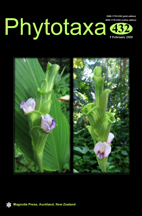Abstract
Based on the results of phylogenetic reconstructions employing two nuclear ribosomal DNA loci (ITS and ETS), as well as morphological observation and comparisons of branches, leaves, inflorescences/infructescences and pyrenes, a taxonomic revision of three species of Ilex from China is conducted and presented herein. Ilex fargesii is subdivided into I. fargesii subsp. fargesii and I. fargesii subsp. melanotricha, with I. fargesii var. angustifolia and I. fargesii var. brevifolia newly treated as synonyms of the type subspecies. The split of the two subspecies of I. fargesii in the molecular phylogeny is conformed with their divergence in distribution, which is clearly separated by the Tanaka-Kaiyong Line. Similar geographic disjunction is also revealed in the two subspecies of I. wattii, i.e. I. wattii subsp. wattii and I. wattii subsp. marlipoensis. Meanwhile, I. gintungensis and I. venosa newly reduced to the synonyms of I. wattii subsp. wattii, and I. marlipoensis and I. cupreonitens to I. wattii subsp. marlipoensis. Furthermore, we confirm I. pubifructa to be a newly recorded species in China and I. denticulata to be excluded from China. Both our molecular and morphological analyses do not support the synonymization of I. chartaceifolia (including I. chartaceifolia var. glabra) and I. micropyrena with I. fargesii. However, the specific status of I. chartaceifolia and I. micropyrena is not resumed in this study because of their intricate and unclear relationships with I. dunniana, I. intermedia and I. subodorata.

